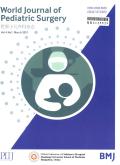Significance of the auditory meatus inferior wall cartilage in the surgical treatment of congenital first branchial cleft anomalies in children
IF 0.8
4区 医学
Q4 PEDIATRICS
引用次数: 0
Abstract
Objective To investigate the clinical significance of the inferior wall cartilage of the auditory meatus in surgical treatment of congenital first branchial cleft anomalies (CFBCAs) in children. Methods Twenty children diagnosed with CFBCAs who underwent surgery between December 2018 and June 2022 at our hospital were retrospectively analyzed and classified according to their Work lesion type. The guiding significance of the inferior wall cartilage in the surgical treatment of CFBCAs was summarized by investigating the adjacent relationships of the surgical lesions with the external auditory canal and facial nerve. Results Of the 20 patients, 16 were classified as Work type I and 4 as Work type II. The lesions were adjacent to the inferior wall cartilage of the auditory meatus in all children. Work type I lesions were located in the upper lateral aspect and were not adjacent to the facial nerve. Work type II lesions were located in the inferior-medial region of the facial nerve. The lesions were completely resected in all children. One patient experienced recurrence 3 months postoperatively because of a residual endochondral fistula. No patients developed facial paralysis or other complications. Conclusions The inferior wall cartilage of the auditory meatus may help to the identify the initial lesion of the CFBCAs and can be regarded as a guiding anatomical structure. These lesions can be completely resected. For resection of Work type II first branchial cleft lesions, the surgical incision can be narrower, and can be precisely positioned with the assistance of endoscope.听道下壁软骨在儿童先天性第一鳃裂畸形手术治疗中的意义
目的探讨听道下壁软骨在儿童先天性第一鳃裂畸形(cfbca)手术治疗中的临床意义。方法回顾性分析2018年12月至2022年6月在我院行手术诊断为CFBCAs的20例患儿,并根据其病变类型进行分类。通过观察手术病变与外耳道、面神经的邻近关系,总结下壁软骨在CFBCAs手术治疗中的指导意义。结果20例患者中,Workⅰ型16例,Workⅱ型4例。所有患儿的病变均位于听道下壁软骨附近。工作型病变位于上外侧,不与面神经相邻。工作型病变位于面神经内内侧区域。所有患儿病灶均被完全切除。1例患者术后3个月因软骨内瘘残留复发。没有患者出现面瘫或其他并发症。结论听道下壁软骨有助于鉴别cfbca的初始病变,可作为指导性解剖结构。这些病变可以完全切除。对于Work型第一鳃裂病变的切除,手术切口可以变窄,在内窥镜的辅助下可以精确定位。
本文章由计算机程序翻译,如有差异,请以英文原文为准。
求助全文
约1分钟内获得全文
求助全文

 求助内容:
求助内容: 应助结果提醒方式:
应助结果提醒方式:


